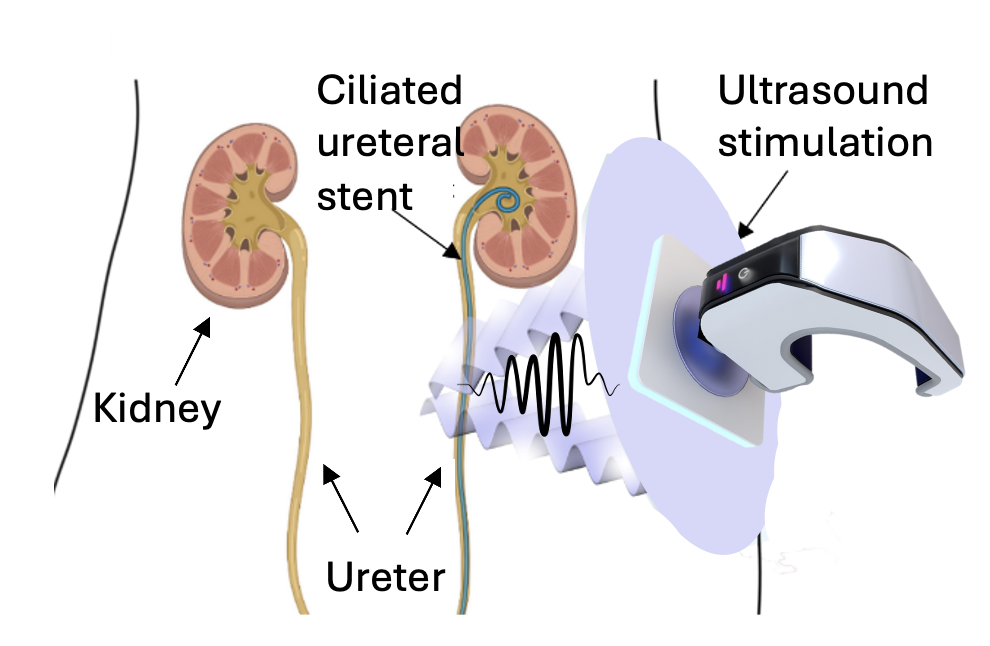"Here, the technology can become a product"
Cornel Dillinger has been working on a novel technology at ETH Zurich to move mini robots during surgery. Now, as a UniBE Venture Fellow, he is using his research knowledge to improve the quality of life for patients with ureteral strictures - with CleanStent.

Cornel Dillinger, what is CleanStent?
CleanStent is a ureteral stent equipped with micro robotic technology. Stents are robust tubes that physicians insert into constricted blood vessels or into the ureter so that fluid can flow through them again unhindered. However, the special technology in CleanStent allows to keep a stent clean inside the body for the first time. This can spare patients from having to undergo the very unpleasant procedure of replacing the stent on a regular basis.
How did this idea arise?
During my doctoral thesis at ETH Zurich, I developed a type of artificial cilia for tiny surgical robots. When they start moving, they generate a flow that allows the robots to “navigate” through fluid-filled cavities in the body. The same principle can also be used to clean ureteral stents.
This idea was developed in collaboration with Francesco Clavica and his research group from the ARTORG Center for Biomedical Engineering Research at the University of Bern, who specialize in engineering solutions for urinary tract diseases. I was contacted and asked if I could adapt my propulsion mechanism accordingly. As initial tests were very promising, the project quickly gained momentum.
What is the goal of your innovation?
Replacing stents in the ureter can be very unpleasant and painful. Currently, these stents must be replaced approximately every two to six months. This is why we want to develop stents that can remain in the body for a longer period without becoming “calcified” due to deposits or without inflammation-promoting bacteria settling on them. Previous approaches to a biofilm-repellent stent surface only delay these side effects but cannot actively combat them.
Our approach makes it possible to clean the implanted stent non-invasively from outside the body. With ultrasound, the cilia on the stent walls are made to vibrate at a frequency of over a thousand times per second. This creates a flow that repels bacteria and crystals, can pulverize deposits and flushes everything out of the body. Deposits can thus be prevented in the long term.

You transferred from ETH Zurich to Bern. What was your motivation?
At ETH, I conducted more fundamental research. In Bern, I can push the technology further and develop it into a product. This aspect made Bern attractive and motivated me to come here: my engineering can generate a targeted and tangible outcome.
With Fiona Burkhard, head physician at the Department of Urology at Inselspital, we also have a clinical expert and device user on board. She has a large network of urologists who would potentially use, implant and then clean such a CleanStent, as well as of patients. That helps us enormously. As Dr. Burkhard tells us exactly what the needs and problems are with current stents, we are now aiming to build a stent that solves these problems in the long term.
How was your start here?
The type of work I picked up in Bern is different than in Zurich. Here, it's really about training my entrepreneurial side. To this end, I have already gone through several programs. The coaching from the Innovation Office, for example, is very helpful. At the same time, I still have a lot of freedom.
Compared to before, I sit in a lot more meetings, negotiate a lot more and write grant applications. That also helps me personally. Because it trains me in an area that has not been in focus during my doctoral thesis. As a result, I spend less time in the lab and more on the business aspect and the viability of the innovation. It's different, but very refreshing.
How important is the UniBE Venture Fellowship for your project?
With the UniBE Fellowship, I am now in exactly the right place. Bern has a unique constellation in which biomedical engineering is embedded in the Faculty of Medicine and with the Bern University Hospital Inselspital as a direct point of contact. This provides interaction and very clear tasks for engineers. Physicians come to us directly with challenges for which they ask us to find innovative solutions.
It is also a very good place to found a start-up. For example, our research group is housed at sitem-insel, where several start-ups are already based. In addition, the fellowship offers us a financial jump-start to build our prototype.

After moving from the Department of Mechanical and Process Engineering at ETH Zurich, Venture Fellow Cornel Dillinger is now based at the ARTORG Center for Biomedical Engineering Research, where he conducts research with Francesco Clavica's group.
What is the next milestone?
In collaboration with external companies, we are looking for scalable approaches to producing artificial cilia. These are very small (in the low two-digit micrometer range) and in previous trials we have tested them on a section of a few millimeters. Now the aim is to fabricate them on a stent that is 20 to 30 centimeters long.
And if it does not work out…?
I consider this a challenge that I am happy to take on. It allows me to apply the unique know-how that I have acquired over the last four to six years. That is very fulfilling.
Of course, I'm also aware of the risks and limitations of ultrasound and microfabrication, which we're borrowing from computer chip technology to produce this stent. But engineering problems are like that: If it were easy, someone would have done it long ago.
What is your advice to others with a business idea?
The most important thing when you come from a research background is to set yourself a clear goal, to tackle a specific problem. You should have this goal that you are working towards in mind at all times, whether in a business meeting or in a laboratory experiment. You must be able to show that you can solve this problem in a new and better way than this was done before.
Venture Fellowship
The Venture Fellowship Program at the University of Bern
The Venture Fellowship Program at the University of Bern enables four young researchers each year to continue their translational research for one year. The program aims to assess the technical feasibility (Proof-of-Concept) of their projects and prepare for their subsequent commercialization. The Innovation Office at the University of Bern supports them with consulting, mentoring, and networking, in cooperation with be-advanced – the startup coaching platform of the Canton of Bern. The fellowships, each endowed with CHF 100’000, are jointly funded by the University of Bern, the ARTORG Center for Biomedical Engineering Research, and the Inselspital. In addition, the Swiss Federal Institute of Intellectual Property (IPI) supports the program with guided patent searches and patent landscape analyses. The next call for proposals will be published in September 2025.
